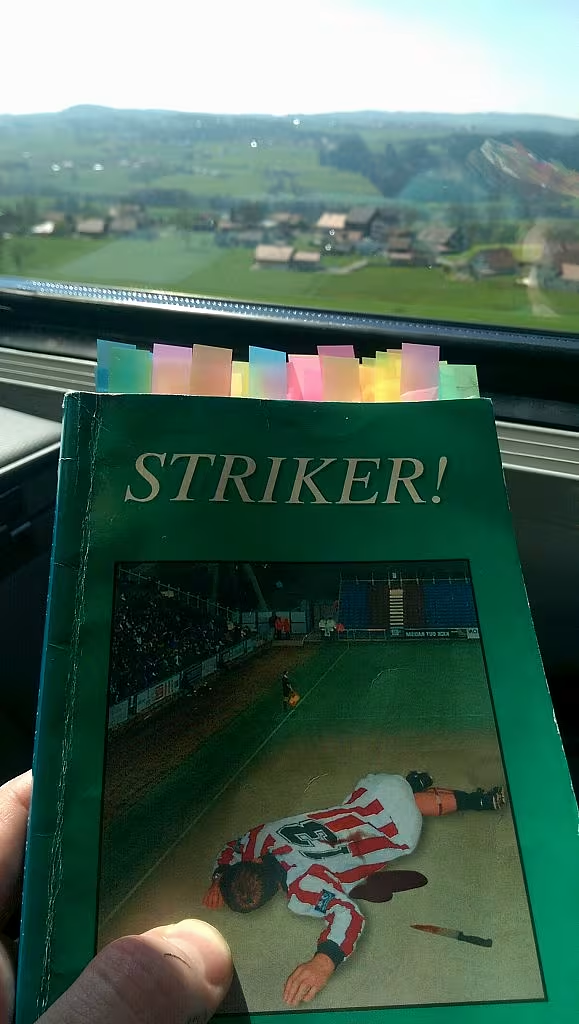Bright red blood on the knife blade.
The knife in my hand.
Duffy’s dead body stretched out on the locker room floor…
And with such drama, begins STRIKER! The first novel by footballer, manager and actual published novelist, Steve Bruce. Written in the first person, Striker puts the reader in the shoes of Steve Barnes, manager of Leddersford Town, a small but historic club hoping to rise to the Premiership from English football’s second tier.
But there’s trouble afoot!
Barnes finds young Irish striker Pat Duffy stabbed to death in the changing room and, becoming suspected of the murder, spends the rest of the book struggling to clear his name. In an odd move, he decides to do so by solving the case on his own, despite (a) the police already being involved, (b) being himself a suspect and (c) his having neither the expertise, training, nor free time available to investigate a murder.
On his quest, Barnes encounters gun-toting Irish thugs, disgruntled baby mamas and treacherous, heavily armed coaching staff. Not to mention a gay, nightclub-owning drug dealer with a glad eye for middle aged football managers and a thrilling top-of-the-table clash between Leddersford and Fulham that’s watched over by a rogue sniper intent on killing our trusty hero.
This is the fizzing geyser of hot nonsense that is Striker.
(The purple tags are solely those which refer to either Bruce’s GCSEs or his Jaguar)
Written in 1999, Striker is generally regarded as the best of Steve Bruce’s novels, and certainly the most readily available. Harper Lee has famously only published one novel in her lifetime. Well, she can eat shit because Steve Bruce has published three. Having said that, no copy of follow-up DEFENDER! has yet been detected on Amazon or eBay, while putting a hand to SWEEPER! will cost the truly dedicated masochist a sanity-warping £70.
See Also: 7 Reasons Why Frank Lampard's Children's Books Are Works Of Great Literary Genius
Even the book’s front cover could itself be a topic for long, detailed discussion. On it, we see our eponymous striker himself, Pat Duffy, face down and bleeding on a drastically awful Photoshop representation of a football pitch, itself so poorly scaled as to render him roughly 40 feet tall. That’s not to say he looks “a bit big”. He is literally scaled 30-40 feet tall. The great painters call this artistic license. Sprawled sideways, on an actual pitch beside a tiny little linesman, Duffy looks here like a recently divorced dad, reduced to crying himself to sleep each night on the Subbuteo mat he leaves laid on his absent son’s bedroom floor. It’s not going to bring him back, and you’ll ruin the nets lying on them like that. Astute observers will notice Duffy is also wearing the number 13, because even Steve Bruce must tire of subtlety sometimes.
So, with above quoted paragraph, we open with Barnes holding a knife over Duffy’s dead body and then the following exchange between Barnes and his immediately suspicious assistant coach, Eddie Carberry;
“I didn’t do it,” I said weakly.
“And England didn’t win the World Cup in ‘66” he sneered.
This heady mix of formulaic mystery plotting and remedial references to football is utilized repeatedly throughout Striker’s breezy 128-pages. Some of the prose shows Bruce’s nous for witty one-liners, as in this moment when the antagonistic Carberry – spoiler: the actual murderer! - seems eager to point the finger at poor old Barnes;
“Duffy had a knife in his back. You don’t stab yourself in the back, do you?”
I almost smiled. Eddie knew all about stabbing others in the back, at least with words.
Zing!
You might be slightly puzzled by the references here to Leddersford Town, so it’s important to note that the book takes place in a partly fictionalised football league, populated with real clubs as well as slightly altered versions of those teams Bruce has played for. So Leddersford Town corresponds to Huddersfield Town, whom Bruce was managing while writing the book. There are also oblique references to his Premier League-winning time at Mulcaster United, and stints at such boundlessly imaginative fictional locales as Carlwell, Threshfield Town, Bridesford United, Doningford and Girlington. One feels Bruce goes well beyond the call of duty in creating this elaborate Rail network of fictional northern cities like a pound shop Westeros filled with black pudding and fags.
The Bruniverse’s strange jumble of thinly-veiled footballing towns becomes particularly unintelligible when it has to awkwardly co-exist with real world clubs and locations. So, for example, Steve Barnes played for Mulcaster United, but recalls spending his days off walking through Manchester’s Trafford Centre. Early on, there is admiration toward the real Alex Ferguson, but Bruce refers only to “my former manager at Mulcaster” when describing Ferguson’s actual managerial accolades. There are also some touchingly blatant bits of wrong-righting, such as when Barnes recalls winning the European Cup with Mulcaster, something which Bruce never actually did himself. Bruce's story of a run-in with the law during his time at Gillingham almost bears more resemblance to the plot than his European exploits with United.
His time as one of the “glamour boys at Mulcaster” has made Barnes something of a celebrity in Leddersford, and he is accustomed to being recognized and fawned over wherever he goes. Now that he’s suspected of murder, this is doubly true, as he notes himself in an early passage;
Julie would need to get her act together offering coffee like that, making a show of herself.
Well, it wouldn’t be long before the police arrived. Murder is a grave crime. There was also the added frisson of it happening down at the local stadium. And it wouldn’t be long before we had the media calling. Those guys miss nothing.
Generally not murders, no.
Nowhere is Barnes’ celebrity status more evident than when he interrogates a nightclub owner whose premises are being patronised by one of his more troublesome players. This bizarre sequence sees Barnes channel his inner private eye. Like Dick Tracy, if he was a mildly concussed Geordie. Having broken into the premises, Barnes dispatches two bouncers with little trouble before angrily confronting Terry, the proprietor. Barnes may be a thoughtful and erudite soul, but Bruce does any hard men reading a courtesy by reminding them he’s “no pussy cat, unless you want a breed of tiger or leopard.”
See Also: If Some Of the Greatest Writers Had Ghosted Roy Keane's Autobiography
Terry is the sort of lisping, mincing, one-dimensional queen that makes Frankie Howerd look like Malcolm X. The mind boggles at Bruce’s reasoning for including this ludicrous character within his already full-blown bonkers novel but thank God he did, else we would have forever missed the following exchange;
The dialogue of Terry, brought to you by the Iona Institute
“You have a very fit body,” he said, evading my question.
“Glad you like it,” I said, smiling sardonically.
It was clear from his words, his manner, that Terry Causton was no ladies man [sic].
But enough plot. The true joy taken of reading Striker is in the endless, inane bits of filler that seem to comprise 70% of its dismal word count.
For example, at one point two Irish gunmen – never thereafter named, identified, or revisited – abduct Barnes at gunpoint because they believe he had something to do with Duffy’s death. They lead him up to a secluded spot in the hills, at which point Bruce stares death in the face and begins delivering a long internal monologue on irrigation which really does need to be read to be believed;
I could make out the reservoirs made to provide water to the big cities of Lancashire. These reservoirs, dotted everywhere in hidden valleys, are themselves fed with water from upland streams. The previous summer had been a wet one, and the streams were torrents still. In order to facilitate the collection of this hill water, the authorities, the Water Board, had constructed concrete watercourses. These allowed faster and more efficient collection of the rain water.
It should be noted that when his surreal tribute to the Lancashire Water Board is being recited to the reader, Barnes has a gun in his back. Some say that scenes from your life will flash before your eyes in life-or-death situations. Steve Bruce reckons it’ll be Wikipedia pages on Northern England’s civic amenities.
See Also: Eamon Dunphy And 6 Other Literary Footballers
During this abduction, the references becomes more specific still, and in one brief 10-page flourish he makes three entirely separate, equally bonkers asides to ancient history, and specifically to the habits of pre-modern humans in the Lancashire area;
Finally, we get around to talking some sedge.
In the Bronze Age, people came here, nomadic tribes. They had powerful tools and they cut down the upland forests. They hunted with dogs and possessed strong arrow heads and spears, driving away or killing the wild animals. These people kept cattle and sheep and goats, which grazed the forest floors. Soon the landscape was cleared, and it only needed rain to erode all goodness from the soil.
Thank God we’ve settled that then. But while the Bronze age is pretty long ago, Steve “Way Back When” Bruce has more than that up his sleeve just two pages later;
Millions of years ago, before man on earth, animals we now associate with tropical Africa roamed this area. They had to move, or perished, with the advance of the Ice Age.
It bears repeating that, not only has this no bearing on the plot – he is at this moment being shepherded to his death by two unknown Irish gunmen - AND such insights are never again returned to or referenced elsewhere in the book.
Some elements, however, do recur; most notably details of his beloved car, a Jaguar XJ8 which seems to have truly been a pretty fancy motor. We can tell this because Bruce tells us at every available opportunity;
“Not my words, Carol, the words of Top Gear Magazine”
I drive a Jaguar XJ8, 3.2, the sports version. It’s a very nice motor; 3.2 litre AJ-V8 all alloy engine. Classic colour interior theme, fluted leather seats, contrast colour keyed facia, figured walnut veneer. As good a motor as you can hope to drive. But not a car you’d choose when trying to follow a Ford saloon in a discreet manner…my registration, license and all other statutory details are fully up to date…
And later;
… I was able to see in the rear-view mirror. The XJ’s electrochromic rear view mirror, and the door mirrors – electrically adjustable and heated – ensured I had clear vision…
Then;
Windscreen wipers seem to lull you to sleep. The automatic climate control wraps you in a cocoon of deceptive warmth. It is parely possible, with the 3.2 litre engine and the 5 speed electronic automatic transmission, to know that you are travelling at speed.
Also;
…I locked the car with central locking. The XJ8 has a food security system with ultrasonic intrusion sensing, radio frequency remote control, and engine immobiliser. All necessary: this is a desirable motor..
Not forgetting;
…I walked to where the Jag was still parked. For a thief to get into that motor, he must be a mechanical and engineering genius. Ten paces from the car I opened the doors using the radio frequency remote control. A police control car, the kind used by traffic control, cruised by. The driver craned his neck to get a view of the Jag. Why not? It’s an attractive motor…
Bruce can also get topical, as when he discusses the powers of the predatory press;
Two people on a boat, far away, can be made to appear to be right next to eachother. You don’t believe me? It happened to Princess Diana and Dodi Fayed.
And he’s not afraid to proffer his thoughts on the encroachments of the digital age;
Shannon’s office was small. There was paper everywhere. On his desk was a PC. A personal computer, not a police constable.
Such wordplay demonstrates the swagger of Bruce, a writer at the peak of his powers, and one who isn’t shy about showing off. This might also explain why he mentions his GCSEs no less than seven times in the course of the book, reminding us that he “managed a good GCSE in English, which is why I can tell you this story now”.
My heart. Is. RACING.
Bruce is a writer unafraid of lofty allusions. Following a visit from Michelle, a mystery blonde claiming to be Pat Duffy’s pregnant lover, Bruce reconciles her with old flame Martin Thornton, another squad member at Leddersford, solving their relationship problems simply by telling them to sit down and be quiet until they love each other again, like a sleepy, taciturn Jeremy Kyle. Afterwards, he reflects on their situation;
I just hoped that he and Michelle would behave responsibly. If he were to beat her up, or even strike her once or twice, I would feel guilty.
Sound.
“A pair of star-crossed lovers,” I said to Julie.
She looked surprised.“That sounds clever, Steve. You have a way with words.”
Modestly put.
“Not me. Old Bill Shakespeare.”
As he’s known to friends.
“Since when did you -?”
“When I was at school,” I replied. “Romeo and Juliet was a set text”
“You never cease to surprise me,” she said.
If you were surprised by Julie’s reaction to Barnes remembering five words from the single most famous play of all time, well, you get used to it in Striker after a while. Several people in the book deliver gob-smacked reactions to the amazingly clever things Barnes says, not to mention how fit, handsome, glamorous and good-at-solving-murders he is. In fairness though, Bruce can also dish out a complement, especially when he recognises a fellow poet someone who, like Old Billy Shakes, also has a way with words. Like the driver who cheers Barnes up on the way to the stadium;
“Take Leddersford up, and you’ll be talk of the town,” the driver said.
I smiled. That was a nice play on words. Talk of the town.
Leddersford Town.
What Bruce needed while he was writing the book was someone to say, “Look, Steve, in the nicest possible way, that’s just not what a play on words is, mate”. Or maybe they did, but as they flapped their gums all he heard was them telling him how fit his body was.
While reading the book, it’s hard not to imagine Bruce in this way, a lone maverick stealing away to his typewriter after a training session. Pencil over ear, tongue in teeth, well-worn copy of Lancashire Moorland Digest open by his side - his lovely big cow’s face set in glassy-eyed focus. The studied concentration on his face giving him the look of Brenda Fricker doing a really hard Sudoku as he earnestly summons forth frothy torrents of hot, sassy verbage to the tap tap tap of his two index fingers and the endless mechanical whirring of his wonderful, literary brain.
This is the kind of focus you need to write a book with the concentrated class of Striker. To actually write down stunning passages such as “An Englishman’s home is his castle. That applies to other nations too”, “I decided to wear tracksuit and trainers. That is the kind of decision I make regularly”, “include me out - drugs is for mugs” or, most memorably, “in a contest between human flesh and a concrete shute, the concrete will always win”. It’s also great to see where all of these classic household phrases originated.
It’s heartening to picture Bruce typing these words, then springing from his red leather desk chair, throwing open the doors to his walnut-panelled study, unveiling the manuscript to polite-but-baffled responses from his loved ones. One might have presumed that there also followed conversations with kind, patient doctors gently explaining in soothing tones, that his family loves him and are just a bit concerned. Perhaps this conversation would be within the comforting environs of a nicely-lit part of an unfamiliar hospital, a few counties over. All of this does, of course, presume that Bruce himself wrote the era-defining novel. In recent years, the authorship of the books have been questioned, by Bruce's son Alex - before our minds were put at rest by the man himself.
See Also: 5 Footballers Who Went On To Write Fiction
Thankfully, Striker and its two sequels were released without risk of Bruce’s involuntary admission to protected housing, and so the world got experience it unhindered, particularly its thrilling conclusion. It would, of course, be presumptuous to imply that Bruce was running out of time or energy at this point, but it does bear mentioning that the end of the novel seems fairly rushed. A rather bewildering series of events - the outing of Eddie Carberry as the killer, his stealing of a weapon from an army facility, his subsequent attempt at murdering Barnes with a sniper rifle AND the climactic game against Fulham which seals Leddersford’s promotion - all take place in the book’s last four pages. This would be easier to understand had the previous 124 pages not contained long, rambling accounts of Lancastrian aqueducts, ancient nomadic tribes and constant references to that bloody car.
More though, as I turned the last page, I found I was sorry it was over. Sorry that I wouldn’t have any more Striker to read. Bruce himself may have been modest about Barnes’ abilities – “I was not Sherlock Holmes, the great fictional detective – so well does the author do his job that many people believe Sherlock Holmes was a real person” - but perhaps in years to come his crime-fighting exploits will earn the same place in the popular imagination as that other great English sleuth; an inspiring genius whose exploits lead generations of readers to think maybe, just maybe, the stories were real.
Perhaps the series’ real legacy is yet to come, as it births a new football-wide passion for crime writing among lumpen, steadfast defenders with heads like baseball mitts, a good GCSE, and a truly great car.
Until I get the 70 quid necessary to buy SWEEPER, we may never know.
This was, astonishingly, a library book…
…a library book that was withdrawn from a library in the Shetlands.




















